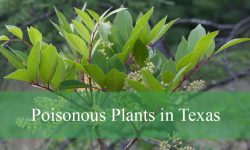North Carolina’s lush forests, rolling mountains, and humid climate create ideal conditions for a wide variety of wild mushrooms. While many are edible and harmless, others hide deadly toxins beneath their beautiful caps. Mushroom foraging in the state can be rewarding — but also dangerously deceptive for those unfamiliar with toxic species.
Throughout North Carolina, from the Blue Ridge Mountains to the coastal plains, several poisonous mushrooms grow naturally under hardwoods, pines, and even in lawns. Some are vividly colored, while others mimic popular edible varieties, making misidentification a real threat. Even small amounts of certain species can lead to severe poisoning or death.
In this guide, you’ll discover 10 of the most poisonous mushrooms in North Carolina, complete with detailed descriptions and identification tips. Learn how to recognize these toxic fungi, understand their effects, and stay safe when exploring or foraging in the wild.
Types of Poisonous Mushrooms Found in North Carolina
Death Cap (Amanita phalloides)
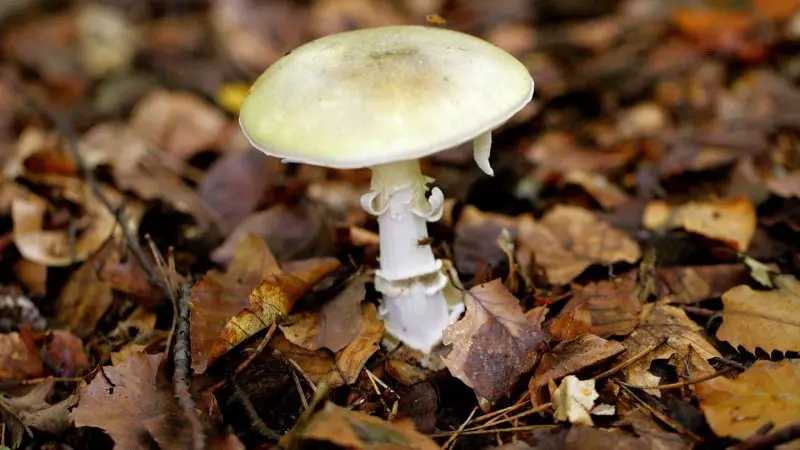
The Death Cap is among the most lethal mushrooms on Earth and has occasionally been found in parts of North Carolina, especially in urban and suburban areas where non-native trees are planted. It features a smooth, greenish-yellow to olive cap that measures between 2 to 6 inches wide, often shiny or sticky when wet. Beneath the cap are pure white, crowded gills, and the stem is also white with a bulbous base wrapped in a distinct cup-like volva — a key identifying feature of this deadly fungus.
This mushroom usually emerges during the late summer and fall months, particularly after heavy rainfall. It thrives in mixed forests and around oak, beech, and chestnut trees, as it forms symbiotic relationships with their roots. In North Carolina, sightings are rare but tend to occur in the Piedmont and western regions. Despite its beauty, the Death Cap poses an extreme danger to foragers who mistake it for edible species like the Paddy Straw Mushroom.
The Death Cap’s toxicity comes from amatoxins, which cause irreversible liver and kidney failure. Even a single cap can be fatal to an adult. The first symptoms — severe abdominal pain, vomiting, and diarrhea — often appear 6 to 24 hours after ingestion, misleading victims into thinking they’ve recovered before organ failure begins. Without immediate medical intervention, survival chances drop drastically.
Due to its resemblance to harmless mushrooms and delayed onset of symptoms, the Death Cap is considered the most deceptive and deadly mushroom in North Carolina. Mushroom hunters are strongly advised to avoid any unknown Amanita species and rely on expert identification when foraging.
Destroying Angel (Amanita bisporigera)
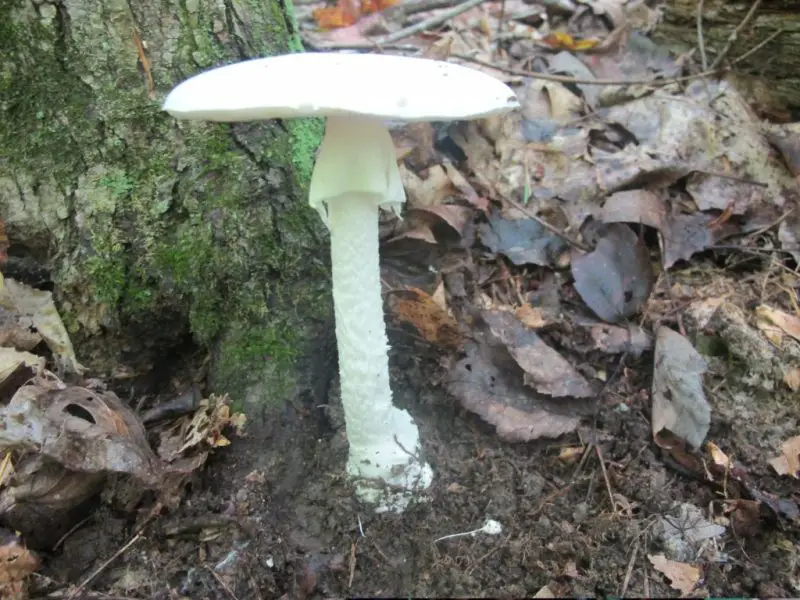
The Destroying Angel is a pure white mushroom that haunts the woodlands of North Carolina with its ghostly beauty and deadly potential. Its smooth, snow-white cap can reach up to 4 inches wide, turning slightly sticky after rain. The gills, stem, and volva are also white, giving it a pristine but deceptive appearance. The cap starts out domed and flattens with age, while the base of the stem is enclosed in a thick, sac-like volva — a signature trait of deadly Amanitas.
In North Carolina, the Destroying Angel commonly appears in summer and fall, favoring moist hardwood forests and shaded areas with rich soil. It forms mycorrhizal partnerships with trees such as oak, hickory, and beech. This species can also appear in grassy yards or near wooded edges, increasing the risk of accidental encounters with foragers and pets.
Like its cousin the Death Cap, the Destroying Angel contains amatoxins, which block RNA synthesis in cells, leading to total liver failure. Symptoms may take 6 to 12 hours to develop and typically begin with nausea, vomiting, and abdominal cramps. A deceptive period of apparent recovery may follow before the toxins cause severe internal damage. In many cases, even advanced medical care cannot reverse the damage.
Despite its alluring purity, the Destroying Angel is responsible for numerous mushroom poisonings each year in the eastern United States. Mushroom enthusiasts in North Carolina are urged to remember this key warning: all white mushrooms with a volva and ring should be treated as deadly until proven otherwise.
False Morel (Gyromitra esculenta)
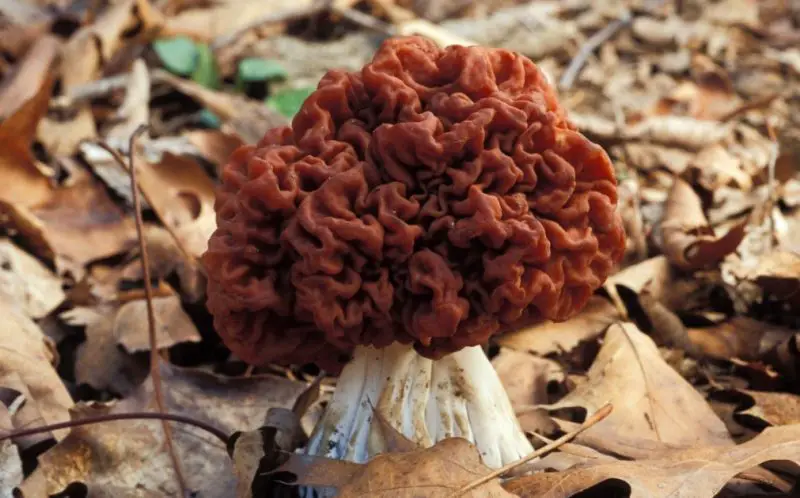
The False Morel is a deceptive mushroom that often tempts inexperienced foragers in North Carolina’s springtime forests. Its wrinkled, lobed, and brain-like cap distinguishes it from true morels, though to the untrained eye, it can look similar. The cap is reddish-brown to chestnut-colored, sitting atop a whitish or pinkish stem that is often chambered rather than hollow. False Morels typically measure between 2 to 6 inches tall and have an irregular, distorted appearance.
These mushrooms appear in sandy or loamy soils, particularly near pine trees and other conifers. In North Carolina, they can be found in the western and central parts of the state, emerging after the first warm rains of spring. They prefer disturbed areas, forest edges, or old logging sites. Their growth pattern and timing often coincide with true morels, making them a dangerous look-alike during foraging season.
False Morels contain gyromitrin, a volatile compound that the human body converts into monomethylhydrazine (MMH) — a highly toxic chemical also used as a component in rocket fuel. Consuming even small amounts can lead to nausea, vomiting, dizziness, and in severe cases, liver failure and seizures. Some individuals may experience delayed symptoms that appear up to 12 hours after eating the mushroom.
Although some regions traditionally parboil and eat False Morels, this practice is extremely dangerous. The toxin can remain even after cooking or drying. In North Carolina, public health authorities strongly discourage any consumption of wild mushrooms unless confirmed safe by an expert.
Jack-O’-Lantern Mushroom (Omphalotus illudens)
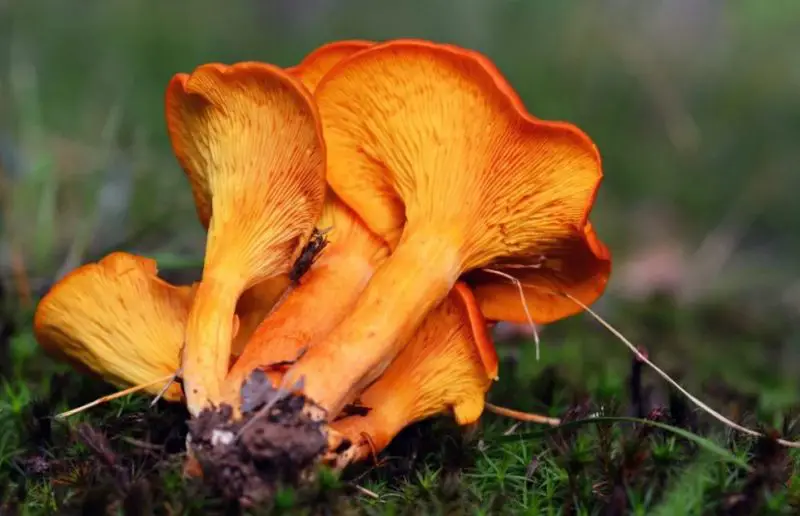
The Jack-O’-Lantern Mushroom is one of the most visually striking fungi in North Carolina, with its vivid orange coloration and faintly glowing gills. Its cap ranges from 2 to 8 inches wide, smooth, and bright pumpkin-orange, sometimes turning darker toward the center. The gills, which run down the stem, emit a soft greenish glow at night — a phenomenon known as bioluminescence, most visible in total darkness.
This mushroom grows in dense clusters on decaying hardwood stumps, buried roots, or at the base of living trees. In North Carolina, it appears from late summer through fall, especially after heavy rains in wooded areas. It’s often found around oak, beech, or maple trees and is a familiar sight in the Appalachian and Piedmont regions. Its clustered growth habit is a key identification clue distinguishing it from the solitary, edible chanterelle.
Although not deadly, the Jack-O’-Lantern Mushroom contains illudins, compounds that cause severe gastrointestinal upset. Symptoms — including vomiting, diarrhea, and cramping — usually begin within a few hours of ingestion and can last for days. The mushroom’s appealing aroma and resemblance to chanterelles often lead to mistaken harvests by novice foragers.
Because of its bioluminescent feature and bright coloration, the Jack-O’-Lantern is often admired by nature enthusiasts but should never be eaten. It plays an ecological role in decomposing wood, contributing to forest nutrient cycles across North Carolina’s diverse ecosystems.
Green-Spored Parasol (Chlorophyllum molybdites)
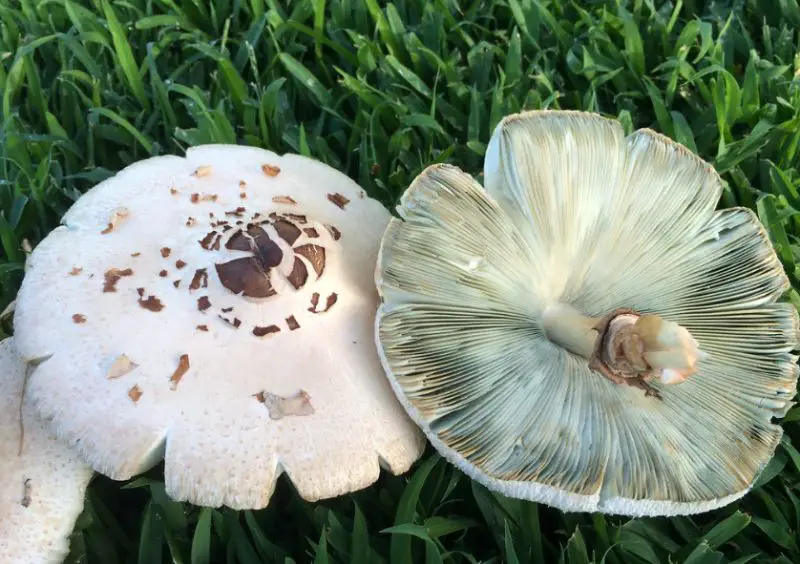
The Green-Spored Parasol is one of the most common poisonous mushrooms in North Carolina, often found right in people’s yards, parks, and golf courses. This large mushroom features a white to tan cap with brownish scales, measuring up to 10 inches across. As it matures, the gills transition from white to pale green — a key identifying feature. Its tall white stem bears a ring and lacks a volva at the base, differentiating it from deadly Amanita species.
Unlike most toxic mushrooms that grow in forests, the Green-Spored Parasol thrives in grassy, open areas and frequently appears after summer rains. In North Carolina, it’s widespread across the coastal plain, Piedmont, and mountain foothills. Homeowners often notice it sprouting in circular patterns, known as “fairy rings,” during humid months.
While not fatal, the Green-Spored Parasol is notorious for causing violent food poisoning. Within one to three hours of ingestion, symptoms such as nausea, vomiting, diarrhea, and abdominal cramps appear. These effects can be severe and lead to dehydration but typically resolve within 24 hours. The toxins are believed to irritate the digestive tract rather than cause systemic organ damage.
Because it closely resembles edible parasol and shaggy parasol mushrooms, misidentification is common among amateur foragers. In North Carolina, this species accounts for the majority of mushroom poisoning reports each year, making it a prime example of why field identification should never rely solely on appearance.
Fly Agaric (Amanita muscaria)
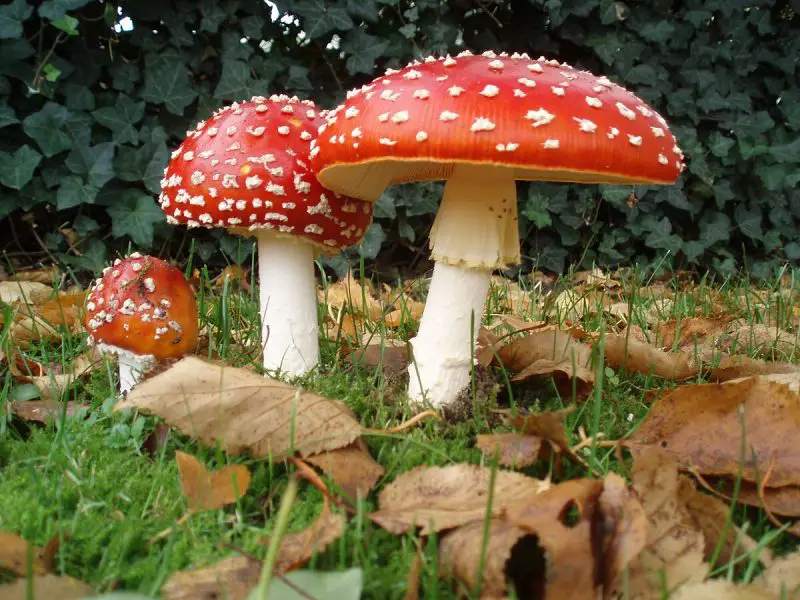
The Fly Agaric is one of the most recognizable mushrooms in the world and is occasionally found in North Carolina’s pine forests and mixed hardwood woodlands. Its bright red cap, dotted with distinct white warts, gives it a fairytale-like appearance. The cap can range from 3 to 8 inches wide, starting as a dome before flattening with age. The gills underneath are white, and the stem is tall and white with a skirt-like ring and a bulbous base partially covered by remnants of a universal veil.
In North Carolina, this species is most often found in the Appalachian Mountains and Piedmont regions, especially during late summer and fall. It forms mycorrhizal relationships with pines, birches, and oaks, preferring moist, acidic soil. The mushroom can appear singly or in groups, often emerging after rainfall. Despite its beauty, the Fly Agaric’s vivid coloring serves as a natural warning to both humans and animals.
The primary toxins in the Fly Agaric are ibotenic acid and muscimol, which affect the central nervous system. Ingestion can cause dizziness, confusion, visual distortions, and muscle twitching. Higher doses lead to intense hallucinations, delirium, and sometimes seizures. Although deaths are rare, poisoning can still be serious and requires medical care.
Historically, the Fly Agaric has been used in shamanic rituals for its hallucinogenic effects, but in North Carolina, it remains a danger to uninformed foragers who mistake it for edible Amanitas. Its toxicity level can vary depending on local environmental factors, making identification and avoidance essential.
Panther Cap (Amanita pantherina)
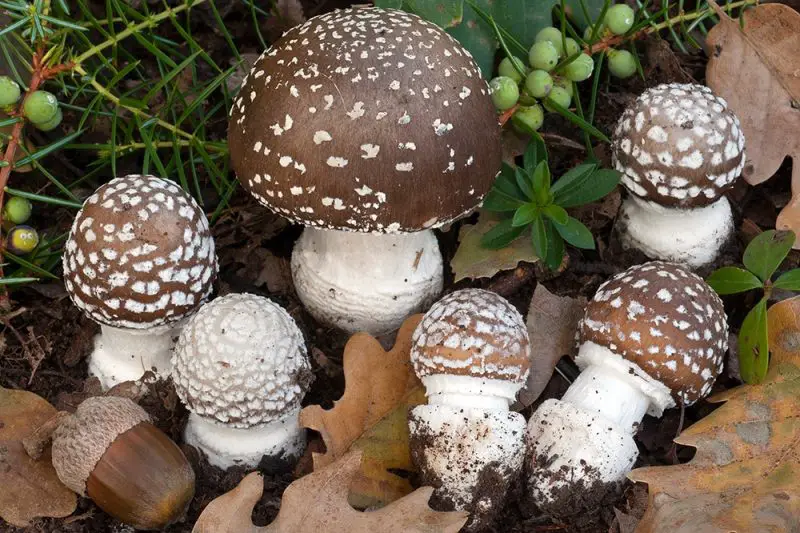
The Panther Cap is a dangerous relative of the Fly Agaric, known for its brown cap adorned with small white warts. The cap, usually 2 to 5 inches wide, has a glossy surface that darkens toward the center. Its white gills and stem, complete with a hanging ring and swollen base encased in a volva, make it visually similar to other Amanita species. This resemblance contributes to frequent misidentifications by inexperienced foragers.
In North Carolina, the Panther Cap grows in wooded areas, particularly near oaks and pines. It favors sandy, well-drained soil and is commonly found in the mountains and western Piedmont during late summer and fall. Its preference for symbiotic relationships with both coniferous and deciduous trees allows it to thrive across varied landscapes.
The toxins muscimol and ibotenic acid found in the Panther Cap affect the brain and nervous system. Poisoning symptoms include hallucinations, confusion, sweating, muscle spasms, and extreme fatigue. Victims may experience alternating periods of hyperactivity and deep sleep, sometimes progressing to temporary unconsciousness or coma in severe cases. While fatalities are uncommon, the risk of neurological distress is significant.
The Panther Cap’s resemblance to edible mushrooms, especially young puffballs or parasols, makes it one of North Carolina’s more deceptive fungi. Experts advise foragers to avoid any brown Amanita species, as distinguishing them from deadly look-alikes can be nearly impossible without close examination.
Deadly Galerina (Galerina marginata)
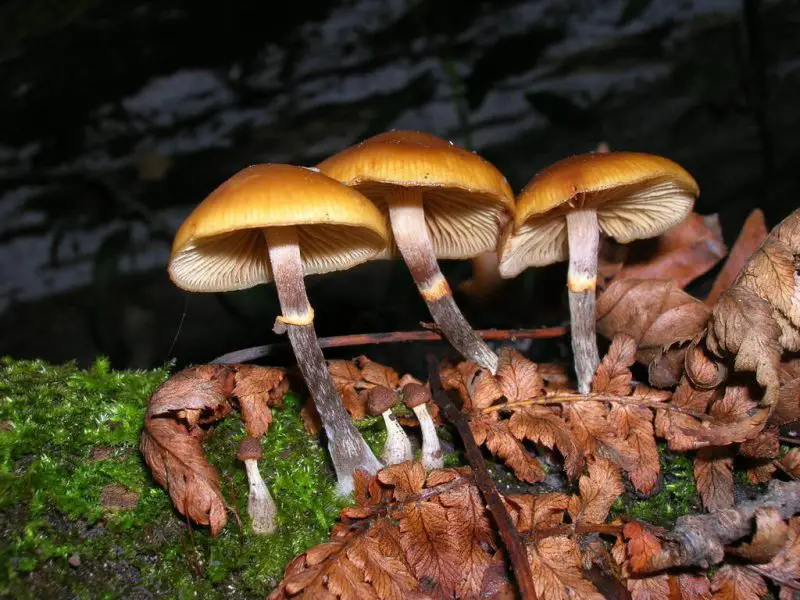
The Deadly Galerina is a small but extremely toxic mushroom that grows on decaying wood, often blending in with harmless species. It features a rusty-orange to brown cap, typically 1 to 3 inches wide, with a smooth, moist surface that darkens when wet. The gills are brownish and attached to a slender, fragile stem that’s lighter at the top and darker toward the base.
This species is widely distributed throughout North Carolina’s forests, thriving on rotting logs, fallen branches, and buried wood. It often appears in the same habitats as edible Honey Mushrooms (Armillaria spp.), leading to tragic cases of misidentification. The Deadly Galerina is found year-round but is most abundant in cool, moist conditions during fall and early winter, especially in the mountain regions.
The mushroom contains amatoxins — the same deadly compounds found in the Death Cap and Destroying Angel. These toxins attack the liver and kidneys, disrupting cell function and leading to irreversible organ failure. Symptoms typically appear 6 to 12 hours after ingestion and include vomiting, abdominal cramps, diarrhea, and jaundice. Without prompt medical treatment, death can occur within days.
Because of its small size and unassuming appearance, the Deadly Galerina often goes unnoticed. North Carolina mycologists warn that any small, brown mushrooms growing on wood should be treated as poisonous unless positively identified by an expert. Even one cap is enough to cause a fatal poisoning.
Ivory Funnel (Clitocybe dealbata)
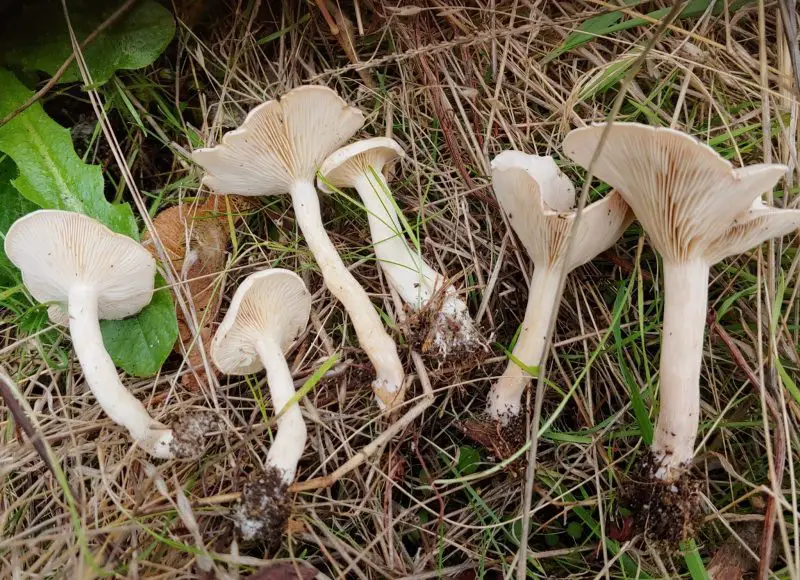
The Ivory Funnel, also known as the Sweating Mushroom, is a small but highly toxic species frequently found in grassy areas across North Carolina. It has a pale white to ivory cap that measures 1 to 2 inches wide, often funnel-shaped with age. The gills are white and crowded, and the thin stem is smooth and slightly curved. Its overall delicate appearance can make it difficult to distinguish from harmless lawn mushrooms.
This species typically grows in lawns, meadows, and grassy fields, appearing after periods of rain from late spring through fall. In North Carolina, it’s especially common in the Piedmont and coastal plain regions where moisture and warmth encourage rapid growth. It often appears in fairy rings or scattered groups, blending easily with the surrounding vegetation.
The Ivory Funnel contains muscarine, a potent toxin that overstimulates the parasympathetic nervous system. Symptoms usually appear within 15 to 30 minutes and include excessive sweating, drooling, nausea, blurred vision, and difficulty breathing. In severe cases, victims may experience slowed heart rate and respiratory failure, which can be life-threatening without medical intervention.
Because of its prevalence in public spaces and resemblance to edible mushrooms, the Ivory Funnel poses a particular risk to children and pets. Residents are advised not to collect or consume any small white mushrooms found in lawns, as the Ivory Funnel’s toxicity can be easily underestimated.
False Chanterelle (Hygrophoropsis aurantiaca)
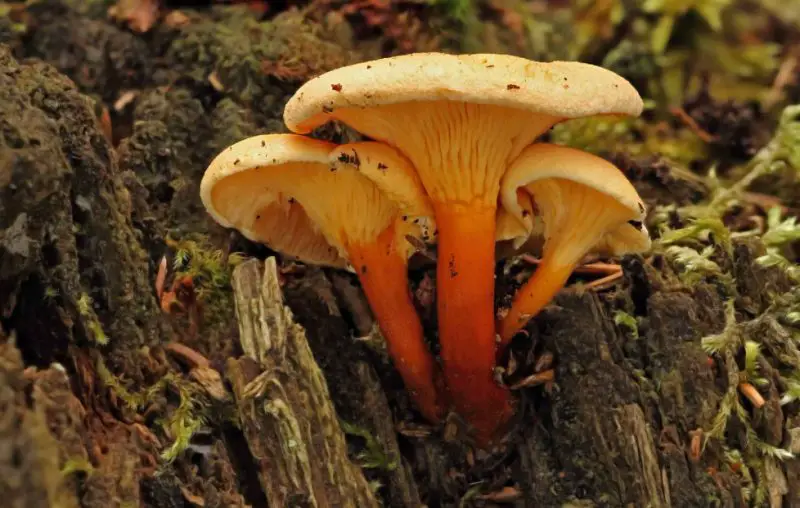
The False Chanterelle is a common mushroom in North Carolina’s forests that mimics the appearance of the edible chanterelle but differs in key details. Its cap is deep orange to reddish-orange and can reach up to 3 inches wide, with a depressed center and finely hairy surface. The gills are thin, crowded, and forked, running slightly down the stem — features that often confuse foragers. The stem itself is slender, yellowish-orange, and paler near the base.
This species prefers damp, acidic soils and is often found growing on decomposing leaf litter or decaying wood. In North Carolina, it thrives in pine and mixed forests, particularly in the Appalachian and Piedmont regions during late summer and fall. Unlike true chanterelles, which grow singly or in small groups, False Chanterelles often appear in large clusters.
Although not considered deadly, the False Chanterelle can cause gastrointestinal distress when eaten in large quantities. Symptoms include nausea, vomiting, dizziness, and stomach cramps. Some individuals may experience stronger reactions depending on their sensitivity. The mushroom’s compounds can also trigger mild neurological effects, although these are rare.
Foragers in North Carolina should take extra care when collecting orange mushrooms. True chanterelles have thick, blunt ridges instead of sharp gills and emit a fruity, apricot-like aroma. The False Chanterelle, while visually appealing, is best admired in nature rather than on the dinner plate.
Tips to Stay Safe When Foraging in North Carolina
Essential Foraging Safety Practices
Only eat mushrooms that have been positively identified by an experienced expert or mycologist. Many edible species have toxic look-alikes that can cause severe illness or death. Avoid any mushroom with white gills, a ring around the stem, or a cup-like structure at the base, as these features are common in deadly Amanita species.
Never rely on online photos or “taste tests” for identification—appearance can vary greatly based on age, environment, and growing conditions. If you are uncertain about a mushroom’s identity, it is safest to discard it immediately. Remember the golden rule of foraging: when in doubt, throw it out.
To deepen your knowledge, consider joining local mycology groups such as the North Carolina Mushroom Club, which offers field identification walks and educational workshops. These programs teach safe foraging practices and help enthusiasts recognize poisonous species found throughout the state.
FAQs About Poisonous Mushrooms in North Carolina
Are there deadly mushrooms in North Carolina?
Yes. The Death Cap (Amanita phalloides) and Destroying Angel (Amanita bisporigera) are both highly toxic and present in certain areas of North Carolina. Even a small bite can cause fatal liver and kidney failure if untreated.
Can cooking or boiling remove the toxins?
No. The deadly compounds amatoxins and gyromitrin are heat-stable, meaning they survive boiling, frying, or drying. Cooking does not reduce their toxicity in any way.
What should I do if I suspect mushroom poisoning?
Call Poison Control (1-800-222-1222) or go to the nearest emergency room immediately. If possible, take a sample of the mushroom or photos of where it was found to assist medical professionals in identifying the toxin.
When do poisonous mushrooms appear in North Carolina?
Toxic mushrooms typically appear in spring and fall, when warm temperatures and heavy rainfall create ideal growing conditions. However, some species can be found year-round in moist or shaded areas.
Can pets be poisoned by these mushrooms?
Yes. Dogs and cats are especially vulnerable. Ingestion can cause vomiting, drooling, weakness, tremors, or seizures within hours. If you suspect your pet has eaten a wild mushroom, seek veterinary care immediately—even small doses can be life-threatening.

